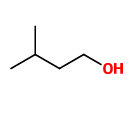
Photo credits: ScenTree SAS
Do you sell any of the raw materials? Would you like to let our users know?
Send an email to fournisseurs@scentree.coto learn about our advertising opportunities.
Do you sell any of the raw materials? Would you like to let our users know?
Send an email to fournisseurs@scentree.coto learn about our advertising opportunities.
General Presentation
-
CAS N° : 123-51-3
-
EINECS number : 204-633-5
-
FEMA number : 2057
-
FLAVIS number : 02.003
-
JECFA number : 52
-
Appearance : Colorless liquid
-
Density : 0,81
-
Volatility : Head
-
Price Range : €€
Physico-chemical properties
-
Molecular formula : C5H12O
-
Molecular Weight : 88,15 g/mol
-
Log P : 1,28
-
Fusion Point : -147°C
-
Boiling Point : 131°C
-
Detection Threshold : Donnée indisponible.
-
Optical rotation : Donnée indisponible
-
Vapor pressure : Donnée indisponible
-
Refractive Index @20°C : Donnée indisponible
-
Acid Value : Donnée indisponible.
-
Flash Point : 42,7°C
Uses
Uses in perfumery :
Year of discovery :
Data not available.
Natural availability :
Data not available.
Isomerism :
Isoamyl Alcohol has no known isomer in perfumery.
Synthesis precursor :
Isoamyl Alcohol can be used in an esterification reaction with acetic acid to form Isoamyl acetate. Reaction with Butyric Acid and Salicylic Acid gives Isoamyl Butyrate and Isoamyl Salicylate respectively. It is also involved in the synthesis of Allyl Amyl Glycolate by reaction with Chloroacetic Acid.
Synthesis route :
The industrial scale preparation of Isoamyl Alcohol is made from fusel oil. Fusel oil is a mixture of liquids from the fermentation of carbohydrates. Fractional distillation of this fermented oil is used to recover Isoamyl Alcohol.
Regulations & IFRA
Allergens :
This ingredient does not contain any allergen.
IFRA 51th :
This ingredient is not restricted for the 51th amendment

